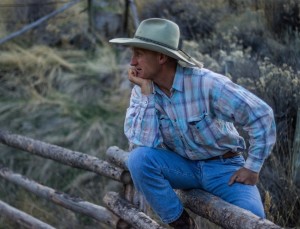West Taylor, owner of Wild West Mustang Ranch and a certified and award-winning TIP trainer, recently spent time with 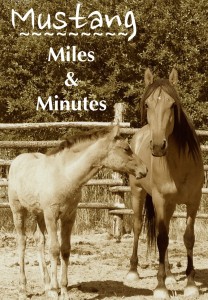 Raechel Nelson and her four-year old mustang, Alita. The horseman also visited with Dr. Steve Peters to discuss Evidence-Based Horsemanship, and the neuroscience behind Taylor’s horse work. Read more about Taylor here.
Raechel Nelson and her four-year old mustang, Alita. The horseman also visited with Dr. Steve Peters to discuss Evidence-Based Horsemanship, and the neuroscience behind Taylor’s horse work. Read more about Taylor here.
The Fremont, Utah trainer worked with Alita as part of BestHorsePractices’ Mustang Miles & Minutes feature. We talked with Taylor, Nelson and Peters after two ground-breaking sessions.
Read comments from Taylor here.
Raechel Nelson:
It was incredible. He worked really well with the horses and also with me. After he worked with 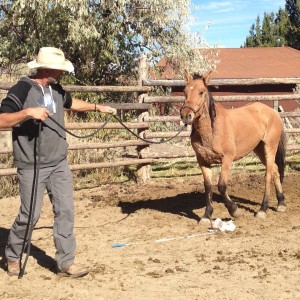 Alita to a point, he asked me to join him in the pen. He didn’t communicate any expectations, which was nice. I think that would have created stress to have goals that might not be realistic or relevant. We just dealt with the here and now. While we humans may think of a goal as a big accomplishment, to the horse, it may be trivial. She may have some different hurdle or challenge that’s a huge deal for her.
Alita to a point, he asked me to join him in the pen. He didn’t communicate any expectations, which was nice. I think that would have created stress to have goals that might not be realistic or relevant. We just dealt with the here and now. While we humans may think of a goal as a big accomplishment, to the horse, it may be trivial. She may have some different hurdle or challenge that’s a huge deal for her.
I learned a lot from watching him and he was really good about communicating what he was doing the whole time and ultimately saying to me: ‘Here’s where you can go with this. Here’s what you do. Let’s put you in there with her. We’ll give you some confidence. We’ll give you direction.’
That was really good.
West did say she has some aggression issues to deal with. We realized that her neck and shoulder area, which is supposed to be a safe place for us to work with her, is not safe at all. She was not comfortable with you there at all.
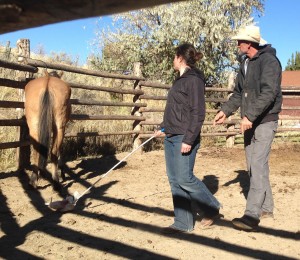 Compared to how Steve and I were working with her and elevating her anxiety, West escalated her much more.
Compared to how Steve and I were working with her and elevating her anxiety, West escalated her much more.
As soon as he got the halter went on, he was teaching her to back. That was in order to keep himself safe and to give her an option other than striking. At first, she went ballistic. It was a rodeo.
He just kept at it with the same kind of pressure, asking the same thing. He was totally even-keeled while he waited for her to sort through her stuff and realize “ok, I can bring myself down and I can find an answer.” Steve and I agreed, if it were us, we would have been out of the round pen, saying ‘holy crap, what just happened?’
A couple things were interesting to see the comparisons between what I’ve been doing and what West was doing.
- He was willing to escalate her reaction a lot higher than I was.
- He was willing to be in a much smaller space than I was.
- When Steve was working with her and throwing a rope, she learned that she could sometimes kick the rope off and get away. But with West, if she kicked the rope off, it landed back on her a second later. She learned that she had to wear it
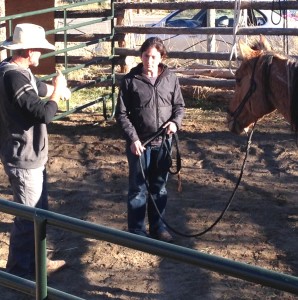 until she was okay with it.
until she was okay with it.
Nelson on considering the square pen, a special feature of Taylor’s training:
So many people say: ‘work them in the round pen so they don’t get hung up in the corners.’ His opinion is exactly the opposite: Every time she goes into a corner, she has to make a decision. She can either get hung up in the corner and feel increased pressure, or make the choice to be with you and pay attention to you.
It’s true. She has the capacity to think that through. In a round pen, we don’t obligate her to do that.
Steve Peters:
West got into the 24 by 24 foot pen and would throw the cotton rope her way. She would kick and paw at it. He eventually got the rope on the other side of her and was able to draw it up and make a loop.
He was pulling on her and getting her to move. Eventually, he took the halter, got it around her head, and swapped it out with the rope. Once that halter went on, any pull on it and she exploded.
West told Raechel, ‘It’s not going to look pretty. But we have to get by this stuff or you’re going to get hurt.’ She leaped, pawed, kicked, fell down, smashed into panels. Once she calmed down, the first thing he taught her was backing. He said this was so important for staying safe. He started by just wiggling the line. She didn’t move. Then he snapped it and she freaked 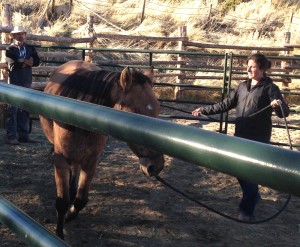 out, reared back, pawed the air. It was total fireworks. But he just kept setting her up and providing her with options. He finally got her to back.
out, reared back, pawed the air. It was total fireworks. But he just kept setting her up and providing her with options. He finally got her to back.
It was really incredible to watch the transformation. So mesmerizing. The time flew by.
Raechel then got halter on a few times with West’s help. He left her in a place that’s safe now. He gave her tools and said she was effective and could keep herself safe and get herself out of trouble if trouble arose.
The kicking and striking is gone because Ali now has three or four new options. When she feels trapped, she can now back. West taught Ali that if you cluck, she can back. She can always take that option. It’s the easiest route for her to take if she starts to be threatened.
West showed Raechel that pressing against the horse with the palms of her hands, so that Ali leaned into it, was better, less threatening than scratches. Initially, the contact should not feel threatening at all. These mustangs 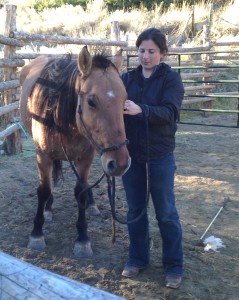 are super sensitive.
are super sensitive.
Not only did Raechel watch her mustang go places she never thought she could take her, West also left her with a huge toolbox of skills she can use.
